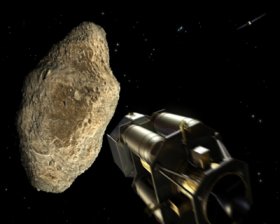We often talk about the need to find and track Earth-crossing objects, but what do we do if we find one that’s likely to hit us? We’re far from demonstrating our ability to deflect an incoming asteroid, making a precursor mission of some kind a necessity. The European Space Agency has been carrying out design studies with three industrial consortia — led by Alcatel Alenia Space, EADS Astrium and QinetiQ — for a precursor mission called Don Quijote that would involve two separate spacecraft.

What the ESA has in mind is to drive an impactor into an asteroid to assess the resulting deflection. The impactor vehicle, called Hidalgo, would hit the target asteroid at a relative speed in the area of ten kilometers per second. The orbiter, called Sancho, would measure the deflection with a high degree of precision and act as a data relay for the approaching impactor. It would also deploy instruments in the form of what ESA calls an ‘autonomous surface package’ to to study the asteroid’s composition and other properties.
Image: The moments before impact… The Impactor spacecraft (Hidalgo) heads towards the target asteroid. Credit: ESA – AOES Medialab.
The late word out of ESA is that a Sancho mission study has been completed that builds on the larger Don Quijote industrial study. As the idea evolves, the agency is talking about first flying a Sancho mission without accompanying impactor to demonstrate key technologies for rendezvous and close operations around the asteroid. At this early stage, both electric and chemical propulsion options are still in the mix, with a launch assumed somewhere between 2013 and 2015. The duration of the preliminary Sancho mission would be four years.
You can read more about Sancho and Hidalgo, the primary components of the Don Quijote mission, here. Based on conventional technologies (although the SMART-1 electrical thruster, if chosen, would need some tweaking for the required seven-year mission lifetime), Don Quijote would tell us a great deal about what is and isn’t possible with some classes of near-Earth objects. Let’s hope that’s knowledge we never have to use in a collision scenario, but the cratered face of the Moon is a nightly reminder that the Solar System is an active, frequently hostile place.


Would someone do some “ballpark math” for this Don Quijote scenario? The Temple 1 impactor changed Temple 1’s orbit by 30 meters only — and that after 17 years.
So how much larger must the impactor be or its speed be for this Don Quijote experiment? Did the Temple 1 experience add much to our knowledge in this regard? If not, why not?
Edg
This must be aimed (so to speak) at smaller objects than Temple 1.
http://www.esa.int/SPECIALS/NEO/SEMZRZNVGJE_0.html
Found some math here.
Edg
Paul, I can find no target list for Don Quijote; I surmised much the same thing.
Hi All
Assuming a density of 1,000 kg (typical for a rubble-pile roid) the target masses about 65 million tons. A 532 kg impactor at 10,000 m/s gives an impulse sufficient to shift the roid by about 2.5 km over a year. Not so good to deflect away from Earth, but it might mean the roid misses a keyhole for an Earth-impacting trajectory. With enough timing and positional accuracy we might be able to engineer useful collisions between larger and smaller asteroids. With a swing past Jupiter we might get our impactor vehicles into very high energy orbits thus giving even bigger kicks to asteroids.
Adam, I’m afraid your math is aimed in the wrong direction. The impact between a spacecraft and an asteroid is not like a billiard ball impact another. Rather, what occurs is that the impactors kinetic energy becomes thermal energy very quickly, this thermal energy vaporizes the impactor and a significant volume of asteroidal material (excavating a crater in the process). This material flies out of the crater in all directions and provides thrust in addition to the tiny impulse of the impactor. How much thrust depends upon the size and speed of the impactor, the geometry of the impact/impact site, and the physical properties of the asteroid. These complications are why even a simple impact mission as described above is valuable in studying asteroid deflection, almost all asteroid deflection schemes will involve using the asteroid’s own material in some way.
Hi Robin
Conservation of momentum is all I needed to work out that figure. I know what you’re talking about, but it’s a lot harder to compute – thus the need for a real “field test”.
Incidentally if the ejecta freely went “in all directions” it would produce no net thrust. Fortunately half of it slams into the asteroid.
Hi again
The physics of this has me intrigued. I wonder if there are any physics papers that discuss impulses delivered via impactors. Any thoughts?
Whats up
i think this plan will work to its fullest i plan to be one of the people that helps perpare for this well haha i wish